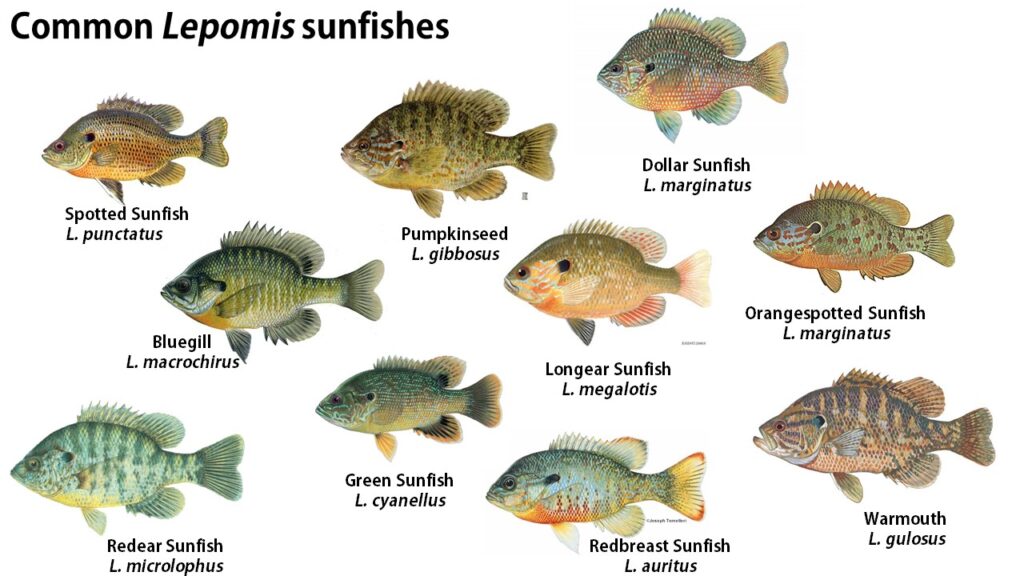Bluegill vs Sunfish: What are the Differences?
Ever wondered about the fascinating world beneath the water’s surface?
Well, get ready to unravel the underwater tale of two captivating fish: bluegill and sunfish. These aquatic wonders may seem similar, but as we take a closer look, you’ll disc
over the unique traits that set them apart.
Taxonomy and Clarification
At first glance, bluegill and sunfish might seem like just two names for the same aquatic creature, but delving into their taxonomy reveals the intriguing science behind their classification.
Taxonomy is like a carefully organized filing system for all living things, allowing us to understand the relationships between species.
Bluegill (Lepomis macrochirus) and sunfish, which is a collective term for various species under the genus Lepomis, share a taxonomical family known as Centrarchidae. This family encompasses a variety of sunfish species, including the famous bluegill.
Within the Centrarchidae family, both bluegill and other sunfish species belong to the Lepomis genus, a subgroup that further refines their classification. However, it’s important to note that while bluegill falls neatly under Lepomis macrochirus, other sunfish species have their own unique names, such as Lepomis gibbosus (Pumpkinseed sunfish) or Lepomis cyanellus (Green sunfish). This demonstrates how taxonomy provides a systematic way to differentiate between similar-looking species and understand their distinct characteristics.
In the grand hierarchy of taxonomy, bluegill and sunfish belong to the following categories:
- Kingdom: Animalia (They are part of the animal kingdom.)
- Phylum: Chordata (Both possess a notochord, which is a defining feature of chordates.)
- Class: Actinopterygii (These are ray-finned fishes, characterized by their fins supported by bony rays.)
- Order: Perciformes (They are part of the perch-like fish order.)
- Family: Centrarchidae (This family encompasses various sunfish species, including bluegill.)
- Genus: Lepomis (Bluegill and some other sunfish species fall under this genus.)
- Species: macrochirus (This is the species name for bluegill, distinguishing it from other Lepomis species.)
Physical Characteristics and Appearance
While both bluegill and sunfish share certain physical traits common to the sunfish family, a closer examination reveals distinct features that set them apart.
Bluegill
- Size and Shape: Bluegill typically measure around 4 to 10 inches in length, with males generally being larger than females. They have a laterally compressed body shape, which means they are flattened from side to side.
- Coloration: Bluegill are renowned for their vibrant appearance. Their body color ranges from olive-green to blue on top, blending into a yellow or orange underbelly. This striking coloration often features iridescent hues.
- Fins and Scales: They possess a dorsal fin, an anal fin, and pectoral fins, each adorned with a spiny-rayed structure. Their scales are small and ctenoid (comb-like), giving their skin a slightly rough texture.
Also Read: Best Bluegill Swimbaits
Sunfish
- Size and Shape: Various sunfish species, including pumpkinseed, green sunfish, and longear sunfish, exhibit a size range of 4 to 10 inches, with variations between species. They share the characteristic laterally compressed body shape.
- Coloration: Sunfish exhibit an array of captivating colors. Pumpkinseed sunfish, for instance, showcase vibrant orange-red spots on their operculum (gill cover) and sides, resembling a pumpkin seed. Green sunfish, as the name suggests, display shades of green and blue on their body.
- Fins and Scales: Similar to bluegill, sunfish possess dorsal, anal, and pectoral fins. The spiny-rayed structure in their fins provides defense against predators. Their scales may differ in size and pattern depending on the species.
Conclusion
It’s worth noting that while bluegill and sunfish exhibit these common physical characteristics, variations occur within the broader sunfish genus, leading to unique appearances among different species.




